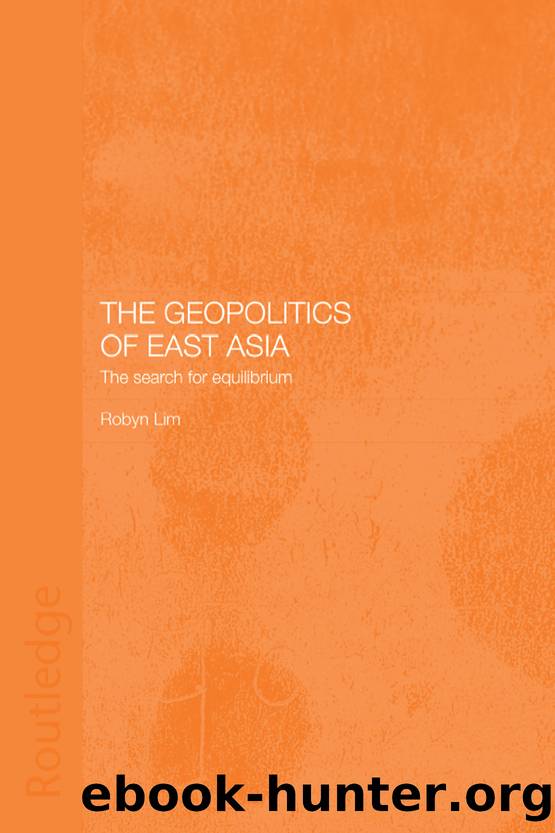The Geopolitics of East Asia by Robyn Lim

Author:Robyn Lim [Lim, Robyn]
Language: eng
Format: epub
Tags: Ethnic Studies, Social Science, Political Science, Regional Studies, General
ISBN: 9781134432707
Google: WB47MvVaDWAC
Goodreads: 17488932
Publisher: Routledge
Published: 2012-10-12T00:00:00+00:00
Australia: bringing the island continent into the central balance
Hitherto, the United States had believed that Australia was too far south to be of much relevance to the global balance. But after the Polaris programme was accelerated, Australia's long Indian Ocean coastline became a strategic asset for America. Polaris submarines carried sixteen nuclear missiles that could reach targets more than 1,000 nautical miles away. Thus these SSBNs were able to target the âsoft underbellyâ of the Soviet Union â including the âsecret citiesâ forming the heart of the militaryâindustrial complex east of the Urals â from submerged firing positions in the northern reaches of the Indian Ocean. Polaris could also target Xinjiang, where China had started to build nuclear testing facilities at Lop Nor in 1959.13 Polaris required the establishment of Very Low Frequency (VLF) communications facilities in the Indian Ocean region. Given the broad expanses of that ocean, Australia was a logical choice to host these facilities. In 1962, the Australian government agreed to the establishment of VLF communications facilities at the barren and remote North West Cape in Western Australia.
By the early 1980s, the deployment of longer-range Trident SSBNs made North West Cape unnecessary for communication with submarines. But the station had other uses. And by that time, Australia had become even more of a strategic asset for the United States. This was a consequence of the development of satellite technology. In 1969, Nurrungar in central Australia became the only ground station outside the United States for the Defense Support Program (DSP) satellites that detected missile launches.
For the United States and Australia, the establishment of these âjoint facilitiesâ at Nurrungar, and at Pine Gap (also in Central Australia), entailed risks for both parties.14 The United States became dependent on the fortunes of a foreign government for facilities vital to its strategic security. What if the host pulled the plug, possibly at a critical moment? For Australia, there were also risks, because the Soviet Union could play on nuclear fears in Australia. But for both parties, the advantages of establishing these facilities far outweighed the risks and costs. Australia thus made a large contribution to the command, communications, intelligence and control structure that sustained Western deterrence and broad international security during the Cold War.
And while Australia was being more closely integrated into the US alliance structure, Khrushchev had become ever more aware of the limitations of the Soviet Union's strategic geography, and keen to redress these problems.
Download
This site does not store any files on its server. We only index and link to content provided by other sites. Please contact the content providers to delete copyright contents if any and email us, we'll remove relevant links or contents immediately.
The Sympathizer by Viet Thanh Nguyen(4090)
The Rape of Nanking by Iris Chang(4019)
World without end by Ken Follett(3339)
Ants Among Elephants by Sujatha Gidla(3278)
Blood and Sand by Alex Von Tunzelmann(3055)
Japanese Design by Patricia J. Graham(2996)
City of Djinns: a year in Delhi by William Dalrymple(2430)
Foreign Devils on the Silk Road: The Search for the Lost Treasures of Central Asia by Peter Hopkirk(2385)
Inglorious Empire by Shashi Tharoor(2344)
The Queen of Nothing by Holly Black(2306)
In Order to Live: A North Korean Girl's Journey to Freedom by Yeonmi Park(2301)
India's Ancient Past by R.S. Sharma(2292)
Tokyo by Rob Goss(2286)
India's biggest cover-up by Dhar Anuj(2240)
Tokyo Geek's Guide: Manga, Anime, Gaming, Cosplay, Toys, Idols & More - The Ultimate Guide to Japan's Otaku Culture by Simone Gianni(2234)
The Great Game: On Secret Service in High Asia by Peter Hopkirk(2227)
Goodbye Madame Butterfly(2161)
Batik by Rudolf Smend(2005)
Living Silence in Burma by Christina Fink(1975)
